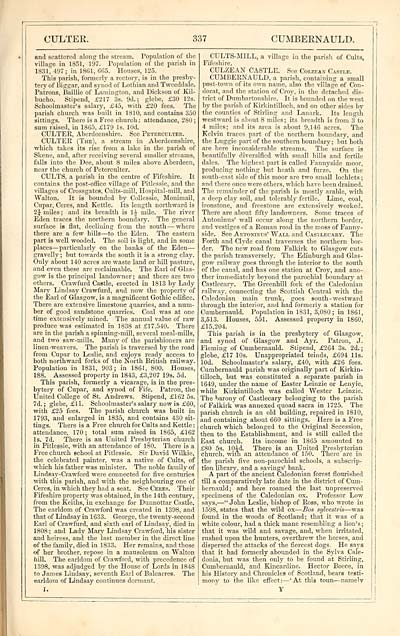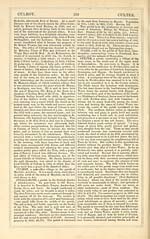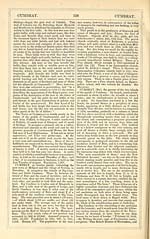Download files
Complete book:
Individual page:
Thumbnail gallery: Grid view | List view

OULTEE.
337
CUMBERNAULD.
and scattered along the stream. Population ol' the
village in 1851, 197. Population of the parish in
1831, 497; in 1861, 665. Houses, 125.
This parish, formerly a rectory, is in the presby-
tery of Biggar, and synod of Lothian and Tweeddale.
Patrons, Baillio of Lamington, and Dickson of Kil-
bucho. Stipend, £217 3s. 9d.; glebe, £30 12s.
Schoolmaster's salary, £45, with £20 fees. The
parish church was built in 1810, and contains 350
sittings. There is a Free church : attendance, 280 ;
sum raised, in 1865, £179 Is. 10d.
CULTER, Aberdeenshire. See Petercultee.
CULTER (The), a stream in Aberdeenshire,
which takes its rise from a lake in the parish of
Skene, and, after receiving several smaller streams,
falls into the Dee, about 8 miles above Aberdeen,
near the church of Peterculter.
CULTS, a parish in the centre of Fifeshire. It
contains the post-office village of Pitlessie, and the
villages of Crossgates, Cults-mill, Hospital-mill, and
Walton. It is bounded by Collessie, Monimail,
Cupar, Ceres, and Kettle. Its length northward is
2J miles; and its breadth is 1J mile. The river
Eden traces the northern boundary. The general
surface is flat, declining from the south — where
there are a few hills — to the Eden. The eastern
part is well wooded. The soil is light, and in some
places— particularly on the banks of the Eden —
gravelly ; but towards the south it is a strong clay.
Only about 140 acres are waste land or hill pasture,
and even these are reclaimable. The Earl of Glas-
gow is the principal landowner ; and there are two
others. Crawfurd Castle, erected in 1813 by Lady
Mary Lindsay Crawfurd, and now the property of
the Earl of Glasgow, is a magnificent Gothic edifice.
There are extensive limestone quarries, and a num-
ber of good sandstone quarries. Coal was at one
time extensively mined. The annual value of raw
produce was estimated in 1838 at £17,540. There
are in the parish a spinning-mill, several meal-mills,
and two saw-mills. Many of the parishioners are
linen-weavers. The parish is traversed by the road
from Cupar to Leslie, and enjoys ready access to
both northward forks of the North British railway.
Population in 1831, 903; in 1861, 800. Houses,
188. Assessed property in 1843, £3,207 19s. 5d.
This parish, formerly a vicarage, is in the pres-
bytery of Cupar, and synod of Fife. Patron, the
United College of St. Andrews. Stipend, £162 5s.
7d. ; glebe, £11. Schoolmaster's salary now is £60,
with £25 fees. The parish church was built in
1793, and enlarged in 1835, and contains 430 sit-
tings. There is a Free church for Cults and Kettle :
attendance, 170 ; total sum raised in 1865, £162
Is. 7d. There is an United Presbyterian church
in Pitlessie, with an attendance of 180. There is a
Free church school at Pitlessie. Sir David WilMe,
the celebrated painter, was a native of Cults, of
which his father was minister. The noble family of
Lindsay-Crawford were connected for five centuries
with this parish, and with the neighbouring one of
Ceres, in which they had a seat. See Ceres. Their
Fifeshire property was obtained, in the 14th century,
from the Keiths, in exchange for Dunnottar Castle.
The earldom of Crawford was created in 1398, and
that of Lindsay in 1633. George, the twenty-second
Earl of Crawfurd, and sixth earl of Lindsay, died in
1808 ; and Lady Mary Lindsay Crawford, his sister
and heiress, and the last member in the direct line
of the family, died in 1833. Her remains, and those
of her brother, repose in a mausoleum on Walton
hill. The earldom of Crawford, with precedence of
1398, was adjudged by the House of Lords in 1848
to James Lindsay, seventh Earl of Balearres. The
earldom of Lindsay continues dormant.
I.
CULTS-MILL, a village in the parish of Cults,
Fifeshire.
CULZEAN CASTLE. See Colzean Casti.e.
CUMBERNAULD, a parish, containing a small
post-town of its own name, also the village of Oon-
dorat, and the station of Croy, in the detached dis-
trict of Dumbartonshire. It is bounded on the west
by the parish of Kirkintilloch, and on other sides bv
the counties of Stirling and Lanark. Its length
westward is about 8 miles; its breadth is from 3 to
4 miles; and its area is about 9,146 acres. The
Kelvin traces part of the northern boundary, and
the Luggie part of the southern boundary; but both
are here inconsiderable streams. The surface is
beautifully diversified with small hills and fertile
dales. The highest part is called Fannyside moor,
producing nothing but heath and furze. On the
south-east side of this moor are two small lochlets ;
and there once were others, which have been drained.
The remainder of the parish is mostly arable, with
a deep clay soil, and tolerably fertile. Lime, coal,
ironstone, and freestone are extensively worked.
There are about fifty landowners. Some traces of
Antoninus' wall occur along the northern border,
and vestiges of a Roman road in the moss of Fanny-
side. See Antoninus' Wall and Castlecary. The
Forth and Clyde canal traverses the northern bor-
der. The new road from Falkirk to Glasgow cuts
the parish transversely. The Edinburgh and Glas-
gow railway goes through the interior to the south
of the canal, and has one station at Croy, and ano-
ther immediately beyond the parochial boundary at
Castlecary. The Greenhill fork of the Caledonian
railway, connecting the Scottish Central with the
Caledonian main trunk, goes south - westward
through the interior, and had? formerly a station for
Cumbernauld. Population in 1831, 3,080; in 1861,
3,513. Houses, 551. Assessed property in 1860,
£15,204.
This parish is in the presbytery of Glasgow,
and synod of Glasgow and Ayr. Patron, J.
Fleming of Cumbernauld. Stipend, £264 3s. 2d.;
glebe, £17 10s. Unappropriated teinds, £694 lis.
lOd. Schoolmaster's salary, £40, with £26 fees.
Cumbernauld parish was originally part of Kirkin-
tilloch, but was constituted a separate parish in
1649, under the name of Easter Leinzie or Lenyie,
while Kirkintilloch was called Wester Leinzie.
The barony of Castlecary belonging to the parish
of Falkirk was annexed quoad sacra in 1725. The
parish church is an old building, repaired in 1810,
and containing about 660 sittings. Here is a Free
church which belonged to the Original Secession,
then to the Establishment, and is still called the
East church. Its income in 1865 amounted to
£80 5s. lOAd. There is an United Presbyterian
church, with an attendance of 150. There are in
the parish five non-parochial schools, a subscrip-
tion library, and a savings' bank.
A part of the ancient Caledonian forest flourished
till a comparatively late date in the district of Cum-
bernauld; and here roamed the last unpreserved
specimens of the Caledonian ox. Professor Low
says, — " John Leslie, bishop of Ross, who wrote in
1598, states that the wild ox — Bos syhestris — was
found in the woods of Scotland; that it was of a
white colour, had a thick mane resembling a lion's;
that it was wild and savage, and, when irritated,
rushed upon the hunters, overthrew the horses, and
dispersed the attacks of the fiercest dogs. He says
that it had formerly abounded in the Sylva Cale-
donia, but was then only to be found at Stirling,
Cumbernauld, and Kincardine. Hector Boece, in
his History and Chronicles of Scotland, bears testi-
mony to the like effect: — 'At this toun — namelv
337
CUMBERNAULD.
and scattered along the stream. Population ol' the
village in 1851, 197. Population of the parish in
1831, 497; in 1861, 665. Houses, 125.
This parish, formerly a rectory, is in the presby-
tery of Biggar, and synod of Lothian and Tweeddale.
Patrons, Baillio of Lamington, and Dickson of Kil-
bucho. Stipend, £217 3s. 9d.; glebe, £30 12s.
Schoolmaster's salary, £45, with £20 fees. The
parish church was built in 1810, and contains 350
sittings. There is a Free church : attendance, 280 ;
sum raised, in 1865, £179 Is. 10d.
CULTER, Aberdeenshire. See Petercultee.
CULTER (The), a stream in Aberdeenshire,
which takes its rise from a lake in the parish of
Skene, and, after receiving several smaller streams,
falls into the Dee, about 8 miles above Aberdeen,
near the church of Peterculter.
CULTS, a parish in the centre of Fifeshire. It
contains the post-office village of Pitlessie, and the
villages of Crossgates, Cults-mill, Hospital-mill, and
Walton. It is bounded by Collessie, Monimail,
Cupar, Ceres, and Kettle. Its length northward is
2J miles; and its breadth is 1J mile. The river
Eden traces the northern boundary. The general
surface is flat, declining from the south — where
there are a few hills — to the Eden. The eastern
part is well wooded. The soil is light, and in some
places— particularly on the banks of the Eden —
gravelly ; but towards the south it is a strong clay.
Only about 140 acres are waste land or hill pasture,
and even these are reclaimable. The Earl of Glas-
gow is the principal landowner ; and there are two
others. Crawfurd Castle, erected in 1813 by Lady
Mary Lindsay Crawfurd, and now the property of
the Earl of Glasgow, is a magnificent Gothic edifice.
There are extensive limestone quarries, and a num-
ber of good sandstone quarries. Coal was at one
time extensively mined. The annual value of raw
produce was estimated in 1838 at £17,540. There
are in the parish a spinning-mill, several meal-mills,
and two saw-mills. Many of the parishioners are
linen-weavers. The parish is traversed by the road
from Cupar to Leslie, and enjoys ready access to
both northward forks of the North British railway.
Population in 1831, 903; in 1861, 800. Houses,
188. Assessed property in 1843, £3,207 19s. 5d.
This parish, formerly a vicarage, is in the pres-
bytery of Cupar, and synod of Fife. Patron, the
United College of St. Andrews. Stipend, £162 5s.
7d. ; glebe, £11. Schoolmaster's salary now is £60,
with £25 fees. The parish church was built in
1793, and enlarged in 1835, and contains 430 sit-
tings. There is a Free church for Cults and Kettle :
attendance, 170 ; total sum raised in 1865, £162
Is. 7d. There is an United Presbyterian church
in Pitlessie, with an attendance of 180. There is a
Free church school at Pitlessie. Sir David WilMe,
the celebrated painter, was a native of Cults, of
which his father was minister. The noble family of
Lindsay-Crawford were connected for five centuries
with this parish, and with the neighbouring one of
Ceres, in which they had a seat. See Ceres. Their
Fifeshire property was obtained, in the 14th century,
from the Keiths, in exchange for Dunnottar Castle.
The earldom of Crawford was created in 1398, and
that of Lindsay in 1633. George, the twenty-second
Earl of Crawfurd, and sixth earl of Lindsay, died in
1808 ; and Lady Mary Lindsay Crawford, his sister
and heiress, and the last member in the direct line
of the family, died in 1833. Her remains, and those
of her brother, repose in a mausoleum on Walton
hill. The earldom of Crawford, with precedence of
1398, was adjudged by the House of Lords in 1848
to James Lindsay, seventh Earl of Balearres. The
earldom of Lindsay continues dormant.
I.
CULTS-MILL, a village in the parish of Cults,
Fifeshire.
CULZEAN CASTLE. See Colzean Casti.e.
CUMBERNAULD, a parish, containing a small
post-town of its own name, also the village of Oon-
dorat, and the station of Croy, in the detached dis-
trict of Dumbartonshire. It is bounded on the west
by the parish of Kirkintilloch, and on other sides bv
the counties of Stirling and Lanark. Its length
westward is about 8 miles; its breadth is from 3 to
4 miles; and its area is about 9,146 acres. The
Kelvin traces part of the northern boundary, and
the Luggie part of the southern boundary; but both
are here inconsiderable streams. The surface is
beautifully diversified with small hills and fertile
dales. The highest part is called Fannyside moor,
producing nothing but heath and furze. On the
south-east side of this moor are two small lochlets ;
and there once were others, which have been drained.
The remainder of the parish is mostly arable, with
a deep clay soil, and tolerably fertile. Lime, coal,
ironstone, and freestone are extensively worked.
There are about fifty landowners. Some traces of
Antoninus' wall occur along the northern border,
and vestiges of a Roman road in the moss of Fanny-
side. See Antoninus' Wall and Castlecary. The
Forth and Clyde canal traverses the northern bor-
der. The new road from Falkirk to Glasgow cuts
the parish transversely. The Edinburgh and Glas-
gow railway goes through the interior to the south
of the canal, and has one station at Croy, and ano-
ther immediately beyond the parochial boundary at
Castlecary. The Greenhill fork of the Caledonian
railway, connecting the Scottish Central with the
Caledonian main trunk, goes south - westward
through the interior, and had? formerly a station for
Cumbernauld. Population in 1831, 3,080; in 1861,
3,513. Houses, 551. Assessed property in 1860,
£15,204.
This parish is in the presbytery of Glasgow,
and synod of Glasgow and Ayr. Patron, J.
Fleming of Cumbernauld. Stipend, £264 3s. 2d.;
glebe, £17 10s. Unappropriated teinds, £694 lis.
lOd. Schoolmaster's salary, £40, with £26 fees.
Cumbernauld parish was originally part of Kirkin-
tilloch, but was constituted a separate parish in
1649, under the name of Easter Leinzie or Lenyie,
while Kirkintilloch was called Wester Leinzie.
The barony of Castlecary belonging to the parish
of Falkirk was annexed quoad sacra in 1725. The
parish church is an old building, repaired in 1810,
and containing about 660 sittings. Here is a Free
church which belonged to the Original Secession,
then to the Establishment, and is still called the
East church. Its income in 1865 amounted to
£80 5s. lOAd. There is an United Presbyterian
church, with an attendance of 150. There are in
the parish five non-parochial schools, a subscrip-
tion library, and a savings' bank.
A part of the ancient Caledonian forest flourished
till a comparatively late date in the district of Cum-
bernauld; and here roamed the last unpreserved
specimens of the Caledonian ox. Professor Low
says, — " John Leslie, bishop of Ross, who wrote in
1598, states that the wild ox — Bos syhestris — was
found in the woods of Scotland; that it was of a
white colour, had a thick mane resembling a lion's;
that it was wild and savage, and, when irritated,
rushed upon the hunters, overthrew the horses, and
dispersed the attacks of the fiercest dogs. He says
that it had formerly abounded in the Sylva Cale-
donia, but was then only to be found at Stirling,
Cumbernauld, and Kincardine. Hector Boece, in
his History and Chronicles of Scotland, bears testi-
mony to the like effect: — 'At this toun — namelv
Set display mode to: Large image | Transcription
Images and transcriptions on this page, including medium image downloads, may be used under the Creative Commons Attribution 4.0 International Licence unless otherwise stated. ![]()
| Gazetteers of Scotland, 1803-1901 > Imperial gazeteer of Scotland, or, Dictionary of Scottish topography > Volume 1 > (447) Page 337 |
|---|
| Permanent URL | https://digital.nls.uk/97464494 |
|---|
| Description | Volume I: Aan-Gordon. |
|---|---|
| Attribution and copyright: |
|

